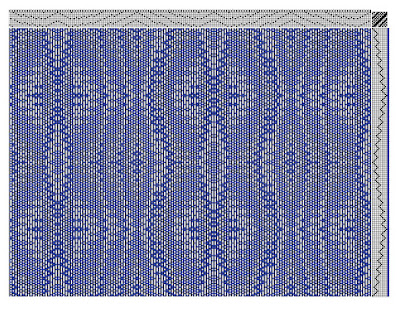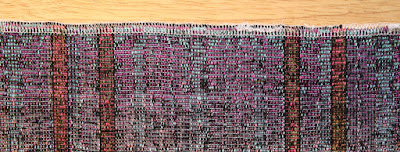 |
So let's walk through the steps in creating this design and weaving the different samples in Echo, Jin, Shadow Weave, Rep and Double Weave. (This is exactly what we do in my workshop, "One Warp, Many Structures: An Exploration of Extended Parallel Threading." I must really like the process, because I keep repeating the format on my own, at home....)
Following one of my other workshops -- "Paint Two, Beam One" -- I hand-painted two warps of 20/2 silk. The first was in a range of blues and the second in purples and rose colors, but I decided I needed more color, so I added two more painted warps in complementary colors, creating four stripes bordered on both sides by two ends of black. And here's how it wove up.
First, how to create the design itself? I think I found the original pattern, a twill pattern with elements of a Crackle threading, on Handweaving.net. Can't remember, exactly, because it could also have been on Pinterest. Both are great places to scan weaving drafts for ideas. Here's what the original draft looks like.
Intricate, symmetrical, appealing -- reminds me of a butterfly! I starting playing on Fiberworks, expanding the design to 12 shafts using an extended parallel threading. And this is one of the designs I came up with: an Echo tieup on an advancing and descending twill treadling.
This sample is the same pattern as in the first photo of this blog post. I used a bronze-colored weft in 20/2 cotton, because the gold tones really warm up the overall tones of the warp. And then I proceeded to weave up samples in Echo, Jin, Shadow Weave, Rep and Double Weave, varying my tieups, treadlings and weft yarns, all on the same extended parallel threading.
I am so grateful to my weaving teachers, particularly Bonnie Inouye and Marian Stubenitsky. I first learned about the potential of extended parallel threadings through a workshop taught by Bonnie, "Opposites Attract," in which she explores the potential of Echo threadings to achieve a broad range of structures. And I also continue to learn from Marian Stubenitsky's definitive work, Weaving with Echo and Iris, in which she took Echo designs and ran with them, showing countless possibilities for variations on 4 to 32 shafts.
As for Rep (below): Well, not so great, but I think it was partly owing to my choice of wefts, where I alternated 20/2 cotton (thin weft) and black rayon chenille (thick weft). I think this sample would have been better if I changed my sett, making it much denser, and chose something thicker and less textured than the chenille for the thicker weft. Nevertheless, I see some potential here!
Here's how my Jin sample wove up, offering yet another example of why I love Jin so much:
And here's how the threading works with Shadow Weave, shown here in a detail:
As for Rep (below): Well, not so great, but I think it was partly owing to my choice of wefts, where I alternated 20/2 cotton (thin weft) and black rayon chenille (thick weft). I think this sample would have been better if I changed my sett, making it much denser, and chose something thicker and less textured than the chenille for the thicker weft. Nevertheless, I see some potential here!
And then I wove up a double-weave sample, which I also like very much:
Just one more, this one in another variation of Echo:
Subtle, yes, but still I like it -- particularly the way the diamond shapes change in both size and color throughout the stripes.
Weaving at home and teaching weaving on Zoom have both given me great comfort this past year. And we all need comfort, even as we are painfully aware of how others lack food, shelter, health care and health itself. This year has given us hardship and hope in equal doses. Friends and loved ones are farther away and closer in our hearts. May you and yours enjoy the blessings of this season of light, however you may celebrate, and may you take comfort in every way you can in the year to come!












10 comments:
Thank you for sharing your process. Really fascinating and totally gorgeous. Am curious how you dressed the loom with the two hand-painted warps. I had a very challenging time integrating two warps using angel wings and a 1/4" raddle and have to wonder if there is an easier way that I'm missing.
Melody, thanks for your interest! I dress the loom from back to front, using two tie-on rods and two sets of lease sticks. To add those warp stripes, I had to VERY CAREFULLY slip those extra warp bouts onto the tie-on rods and then around the lease sticks, holding the other warps in my trembling hands ;o) It was not an efficient method. I am thinking now, if I do this again, I will try dressing the loom front to back, as Randall Darwall did and as Kathrin Weber does. Seems smarter to me, when you’re working with different warp bouts placed here and there! I welcome any suggestions.
I am amazed at what you design, dye, and weave. This one makes me think of Blazing Shuttles with the stripes. You give me inspiration and a desire to finish dyeing the warp I started in your class.
I just read your reply to Melody and I agree that beaming F2B is the best way to integrate 2 or more warps. It eliminates the need for extra lease sticks and apron rods.
Thanks, Debbie! Please send photos of your results!
Thanks, Denise. I especially wondered about those splendid warp stripes. I also beam F2B. Used a 1" raddle in the back and 1/4" raddle on the front. Will never again try pipe cleaners in place of ties so should go bit more smoothly next time. My whole procedure felt like a Rube Goldberg arrangement.
Melody, do you have a source that I can find to show your process? F2B is really new to me. Can't envision where the raddles go....
Hi Denise,
I am a huge fan of your work, and like the same things, though I have not progressed as much as I would like to. Regarding the B2F/F2B methods, I've only done B2F, but would love to hear how your trials go for the other direction. When you paint warps, do you have a favorite length? Sampling and a product? Looking forward to your Zoom in Seattle next spring - if I get in!
Mimi, thank you! When I paint warps, I have painted as much as a 12-yard-long warp (for fabric for a garment) -- but usually I stick to about 6 yards in length. That leaves room for lots of samples and a scarf at the end. I've become dedicated to sampling and recording what I've done, mainly because I'm teaching but also for my own records, because you tend to build on what you've done.
Product: For me, it's scarves and shawls. I'm not a jewelry person, so I consider a scarf more like a necklace -- plus, I live in a wintry climate.
And F2B warping: That's what Randall Darwall always did, because he would paint his warps and then (as I understand it) design in the reed. So I'm thinking I want to move more in the direction of combining multiple (more than two) painted warps in my fabric. I haven't gotten there yet but I will write about it in my blog. It just seems to awkward to me, because I've done it only once or twice.
Hope to meet you on Zoom!
Hi Denise,
I have a question about expanding the draft from 6 to 12 forming the echo. I can expand the parallel threading to additional color, but when I add shafts up, I don't get a perfect echo. Can you walk me through the steps again?
Post a Comment